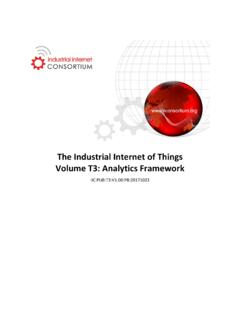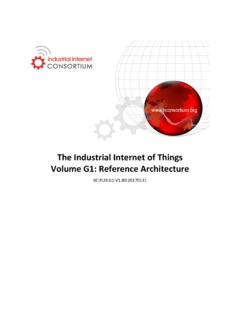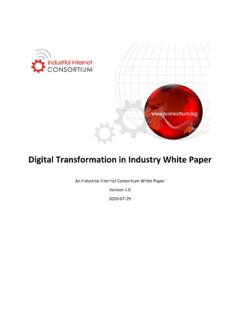Transcription of Global Industry Standards for Industrial IoT
1 Global Industry Standards for Industrial IoT An Industrial Internet Consortium White Paper Claude Baudoin (OMG), Erin Bournival (Dell Technologies), Erich Clauer (SAP SE) CONTENTS 1 Standards Development Organizations and Industry Consortia .. 2 Standards Development Organizations .. 2 Industry Consortia and Associations .. 3 2 Categories of Standards .. 4 3 Defining a Standards 5 Intellectual Property (IP) vs. 5 Rationale for Standards Adoption .. 8 Defining an Enterprise s Standards Engagement Strategy .. 9 Forms of Standards Engagement .. 10 Drivers of a Strategy Choice .. 12 Standards Adoption and the Product Lifecycle .. 12 Standards Strategy for End Users .. 13 4 Executing the Standards Strategy .. 13 Assess the Product Portfolio .. 13 Implement a Standards Watch Function .. 14 Define the Enterprise Standards Process .. 19 Governance of Standards Activities .. 20 5 Conclusion.
2 21 Appendix A: Catalog of Standards Organizations .. 22 Standard Development Organizations .. 22 Industry Consortia and Associations .. 25 Authors and Legal Notice .. 28 IIC Global Industry Standards for Industrial IoT 1 The Industrial Internet of Things (IIoT) is a rapidly expanding world of connected objects. As IIoT systems proliferate, large amounts of data are consumed by machine learning algorithms and shared between partners, customers and others. IIoT is a technology environment in which integration and interoperability are critical capabilities and the complexity of this environment makes this difficult to achieve. Standards play a critical role in IIoT for five main reasons. First, users and vendors cannot engineer a custom interface every time components or systems need to interact. Standards can make this explosion of interfaces manageable; they are the lingua franca for interoperability.
3 For suppliers, this eliminates needless costs related to common capabilities instead encouraging a focus on innovations that add value. Second, Information Technology (IT) and Operational Technology (OT) need to work together to achieve digital transformation of the enterprise, and this implies that OT can no longer deploy isolated islands of automation, often comprising equipment from a few vendors, that do not conform to the protocols or data formats used elsewhere. To achieve the benefits of IIoT, those environments are now connected to enterprise systems and to each other through the internet, and must therefore adhere to IT communication, security and data norms. Third, customers are requiring Standards compliance to avoid vendor lock-in. This creates a competitive environment in which failure to support Standards international, regional, Industry -specific or function-specific becomes a competitive disadvantage.
4 Conversely, active involvement projects a supplier s thought leadership and increases customer confidence. Fourth, regulatory agencies respond to the need for safety, security, and reporting by requiring adherence to Standards to make their monitoring and auditing work feasible. Fifth, Standards make employee skills portable across divisions and companies, which benefits both the workforce and the companies that employ them by flattening the learning curve. Organizations (such as IIC members) must respond to these imperatives by defining a Standards strategy and taking certain actions to execute it. The strategy could be simply to adopt and implement Standards as they emerge, but this limited engagement exposes the organization to surprises. Participating in Standards development organizations (SDOs) provides greater control and allows an organization to anticipate the emergence of new Standards .
5 This requires a commitment at all levels and affects the organization, its processes, product design and budget. This document examines the above in detail. It enumerates categories of Standards and the organizations that produce them. It establishes a vision and strategy to drive and leverage Standards . Also, it provides concrete guidance to the Industry on execution and governance. In short, this document fulfills Industrial Internet Consortium s (IIC s) goals of recommending classes of Standards to the members, influencing Standards development in the interest of our community, and demonstrating the value of Standards by deploying them in our testbeds. We IIC Global Industry Standards for Industrial IoT 2 encourage IIC members to apply this guidance in the development, adoption and use of IIoT Standards , enabling interoperability and system compatibility across the whole IIoT ecosystem.
6 1 Standards DEVELOPMENT ORGANIZATIONS AND Industry CONSORTIA This section describes the landscape of SDOs, Industry consortia and associations involved in the development and adoption of Standards . We have produced a catalog of such organizations relevant to the IoT domain. This catalog appears in Appendix A. Note that any static catalog of this kind is liable to become obsolete quickly, as the list can be neither permanent nor exhaustive. Figure 1-1 depicts the types of organizations, placing them along a horizontal axis corresponding to the phases of a Standards lifecycle. Figure 1-1: Organization Types and Their Standards Lifecycles Standards DEVELOPMENT ORGANIZATIONS Standards development organizations, by definition, develop and publish Standards . A standard is a repeatable, harmonized, agreed and documented way of doing something, and is generally established by an accredited institution. Some SDOs have been established by national or international authorities and are recognized as authoritative by them.
7 The best-known example of those is probably the International Organization for Standards (ISO). An extensive market of commercial companies that provide training and compliance certification is usually associated with those Standards . SDOs tend have defined processes to work together. For example: IIC Global Industry Standards for Industrial IoT 3 the adoption of an ISO standard requires reviews and votes by the SDOs of member countries ( , American National Standards Institute [ANSI] for the United States, Deutsches Institut f r Normung [DIN] for Germany, Association Fran aise de Normalisation [AFNOR] for France). Object Management Group (OMG), the parent organization of the IIC, has an agreement with ISO that allows an OMG adopted specification to be submitted to ISO as a publicly available specification (PAS), often resulting in faster adoption as an ISO standard.
8 Industry CONSORTIA AND ASSOCIATIONS A consortium (plural: consortia) is an association of two or more individuals, companies, organizations or governments (or any combination of these entities) with the objective of participating in a common activity or pooling their resources for achieving a common goal. 1, 2 The IIC is such a consortium; so is its sister program, the Digital Twin Consortium (DTC). IIC member companies have assembled to find solutions for the next Industrial revolution, mainly to identify and document the requirements for new technologies and new business models. Many consortia, such as IIC, do not develop Standards themselves; however, they often advocate for them. When the need for a standard emerges out of the members collaboration, the consortium will either identify an existing suitable standard, or will approach an SDO (with a process detailed in the next section) to encourage the development of a new standard.
9 The consortium members then become some of the subject matter experts who can help the SDO define the requirements for the standard and test it once it is developed. Consortia and Industry associations can have a number of goals: Some exist to share knowledge and provide networking opportunities to their members ( , periodic Industry conferences). Others are formed to influence policy that is, to lobby governments to adopt or reject policies and regulations to maximize the Industry s freedom of action (and profits). This is usually done at the regional level, matching the structure of each government. Some exist to facilitate the development of shared technology, which nowadays may take the form of an open source project. Finally, some consortia and associations create specifications that, without having the force of a standard from an SDO or consortium, are voluntarily adopted by a plurality of the association s members, thus becoming a de facto standard.
10 1 2 IIC Global Industry Standards for Industrial IoT 4 2 CATEGORIES OF Standards External Standards comprise four main categories: open, closed, de jure and de facto. An open standard:3 offers everyone the ability to participate in the development of a standard without barriers to entry, either without cost or for a nominal administration fee, offers everyone the ability to obtain the published version of a document, either without cost or for a nominal fee and places no or few restrictions on their use. Open Standards are publicly available and have various rights-to-use associated with them, and the authoring process used to develop open Standards can vary widely. There is no single definition for an open standard and interpretations vary with usage. Open Standards are generally developed in public settings with open membership, allowing all interested stakeholders to participate under well-publicized bylaws, contribution policies and deliverable licensing terms such as royalty free (RF) or Reasonable and Non-Discriminatory (RAND) terms.











